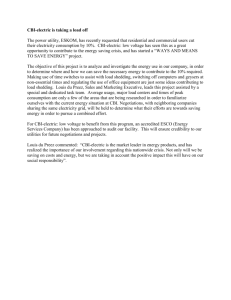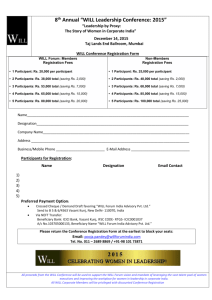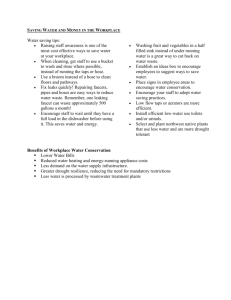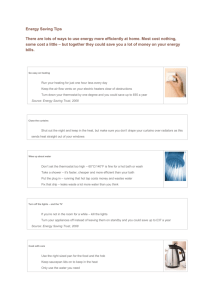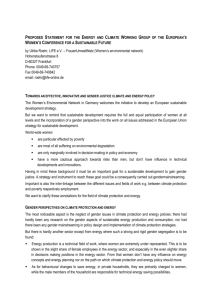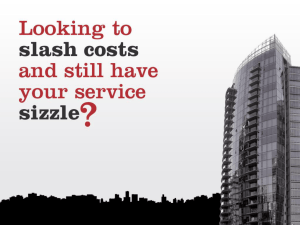Beverage Industry - Australian Industry Group
advertisement
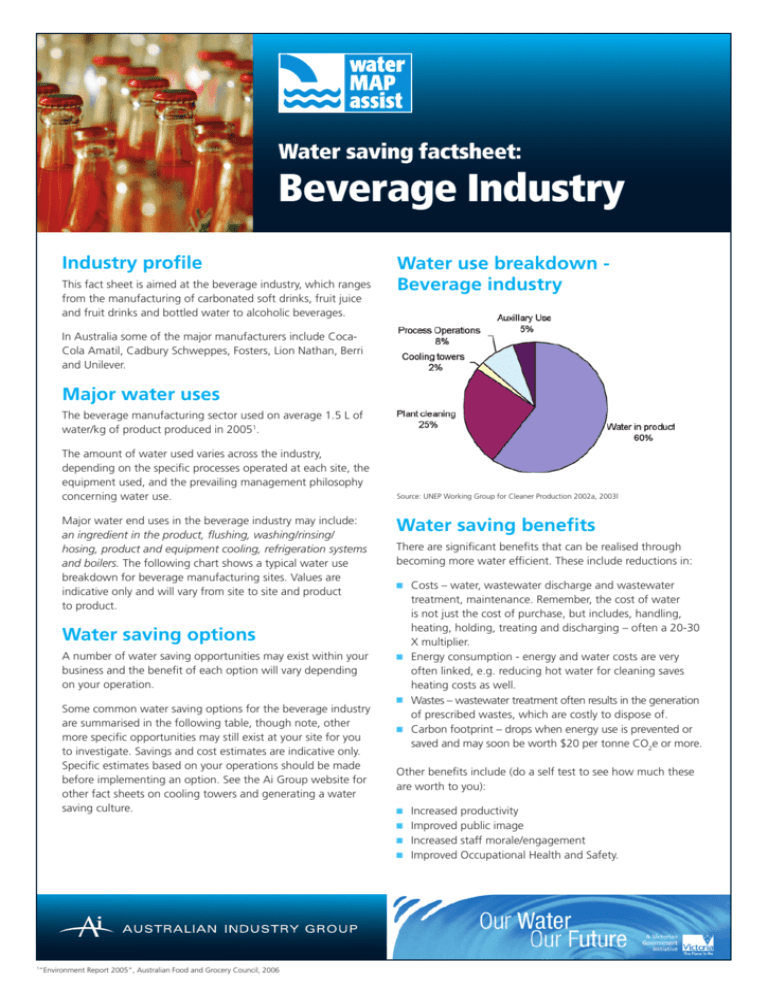
Water saving factsheet: Beverage Industry Industry profile This fact sheet is aimed at the beverage industry, which ranges from the manufacturing of carbonated soft drinks, fruit juice and fruit drinks and bottled water to alcoholic beverages. Water use breakdown Beverage industry In Australia some of the major manufacturers include CocaCola Amatil, Cadbury Schweppes, Fosters, Lion Nathan, Berri and Unilever. Major water uses The beverage manufacturing sector used on average 1.5 L of water/kg of product produced in 20051. The amount of water used varies across the industry, depending on the specific processes operated at each site, the equipment used, and the prevailing management philosophy concerning water use. Major water end uses in the beverage industry may include: an ingredient in the product, flushing, washing/rinsing/ hosing, product and equipment cooling, refrigeration systems and boilers. The following chart shows a typical water use breakdown for beverage manufacturing sites. Values are indicative only and will vary from site to site and product to product. Source: UNEP Working Group for Cleaner Production 2002a, 2003l Water saving benefits There are significant benefits that can be realised through becoming more water efficient. These include reductions in: n Water saving options A number of water saving opportunities may exist within your business and the benefit of each option will vary depending on your operation. Some common water saving options for the beverage industry are summarised in the following table, though note, other more specific opportunities may still exist at your site for you to investigate. Savings and cost estimates are indicative only. Specific estimates based on your operations should be made before implementing an option. See the Ai Group website for other fact sheets on cooling towers and generating a water saving culture. n n n Other benefits include (do a self test to see how much these are worth to you): n n n n “Environment Report 2005”, Australian Food and Grocery Council, 2006 1 Costs – water, wastewater discharge and wastewater treatment, maintenance. Remember, the cost of water is not just the cost of purchase, but includes, handling, heating, holding, treating and discharging – often a 20-30 X multiplier. Energy consumption - energy and water costs are very often linked, e.g. reducing hot water for cleaning saves heating costs as well. Wastes – wastewater treatment often results in the generation of prescribed wastes, which are costly to dispose of. Carbon footprint – drops when energy use is prevented or saved and may soon be worth $20 per tonne CO2e or more. Increased productivity Improved public image Increased staff morale/engagement Improved Occupational Health and Safety. Water saving factsheet: Beverage industry Things to consider when implementing water saving options As always, before implementing a water saving option the potential downsides should be considered. These may include: Increased energy consumption: For example, replacing an evaporative (“wet”) cooling system with an air cooled (“dry”) system can sometimes increase the facility energy consumption. n Increased wastewater (trade waste) contaminant concentrations: n n – Overall quantity by mass (e.g. kg/day) may not increase, but concentration might. – Talk to your water corporation to determine whether increasing concentrations are a safety issue in the sewer or whether a treatment option may become available as a result – e.g. a higher BOD may mean an opportunity for the generation of biogas and secondary generation of electricity. Increased maintenance requirements may occur, depending on the project. Please contact Ai Group or your local water corporation when considering water saving options. Water savings options – beverage industry = <5% total water saving, = 5-10% total water saving, $ = up to 10k, $$ = 10k - 100k, $$$ = > 100K Option Cost = > 10% total water saving Water Saving Hierarchy Category Improve energy efficiency of operations – Reduce $ Dry sweep all areas before hosing – Avoid $ Install flow restrictors on tap water supply lines. – Reduce $ Use high pressure cleaners rather than high volume hoses for cleaning surfaces. – Reduce $ Eliminate leaks – Avoid $ – $$ Use alternatives to liquid ring pumps, vacuum pumps that require seal (gland) water – Avoid $–$$ Use water efficient nozzles for spray rinsing/hosing. – Reduce $ – $$ Use counter-flow washing/rinsing – Reduce $ - $$ Use conductivity rinse controls and minimise timers. – Reduce $ - $$ Install water efficient staff amenities. $ – $$ Re-use equipment cooling water (e.g. shrink tunnels) in boilers or for wash-down. – Re-use $ – $$$ Reuse ‘waste’ water for toilets, irrigation (e.g. product flush water, bottle rinse water). – Re-use $$ – $$$ Reuse water from the critical rinse stage in a less critical rinse stage (e.g. CIP systems). – Re-use $$ – $$$ Treat site wastewater and recycle internally. – Recycle $$ – $$$ Rain water tanks – Alternative sources $$ – $$$ Stormwater harvesting – Alternative sources $$ – $$$ Groundwater – Alternative sources Class A recycled water (e.g. boilers, cooling towers) – Recycle 0 – $$ Contact your local water corporation Option Description Reduce Source: “Water efficiency and water saving factsheets for Industry”, PB, 2008 Further information Contact Ai Group’s Energy and Sustainable Business Helpdesk on 1300 733 752 or at sustainablebusiness@aigroup.asn.au or visit the Ai Group website at www.aigroup.com.au. AIG7082_BEVERAGE
